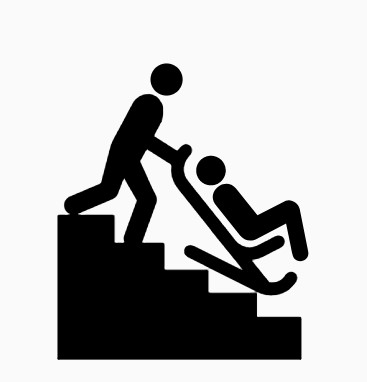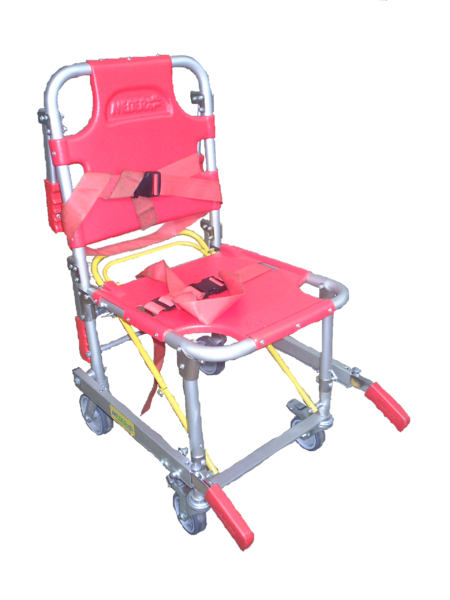Evacuation chair
Contents |
[edit] Introduction
Building evacuation is the process of making sure everyone inside a building gets out safely and in a timely and controlled manner in the event of an emergency, such as a fire. Buildings commonly use equipment such as fire alarms, exit signage, emergency lighting and emergency escape routes to facilitate evacuations.
Multi-storey buildings may also be equipped with evacuation chairs (also known as escape chairs, disabled evacuation chairs, stairway evacuation chairs, fire evacuation chairs or evac chairs) strategically located in protected areas such as corridors or stairways. These devices can be used to assist people with limited mobility (due to an injury, mental health condition, pregnancy or other physical condition) so they can use the stairwell and exit the building safely.
[edit] What is an evacuation chair?
An evacuation chair is a lightweight device that can assist a person with limited mobility to use a stairway. The device is meant to be operated by one person and should require minimal training. It is designed to reduce the amount of heavy lifting that could be required in the event of an evacuation.
Evacuation chairs move at a controlled speed down a portable ramp or track to transport the person to the ground. Some chairs are motorised while others are manually transported.
[edit] Legal requirements
The Regulatory Reform (Fire Safety) Order 2005 (RRFSO) states that it is up to the 'responsible person' (the person in control of the building) to provide a fire safety risk assessment. This assessment should include an emergency evacuation plan along with any evacuation chair requirements.
The assessment should be designed for all people (including those with special mobility requirements - such as visitors) who are likely to be on the premises. This is particularly important in public buildings, healthcare facilities, schools, care homes and other structures that support people with disabilities. In these types of facilities, it is up to the responsible person to make sure the evacuation chairs are in place and in proper working order.
[edit] Related articles on Designing Buildings
- Building evacuation.
- Chair.
- Evacuating vulnerable and dependent people from buildings in an emergency FB 52.
- Protected escape route.
- Protected stairway.
- Responsible person.
- Risk assessment under The Regulatory Reform (Fire Safety) Order 2005.
- The need for company fire risk assessments.
- The Regulatory Reform (Fire Safety) Order 2005.
- Wheelchair user.
Featured articles and news
Government consultations for the summer of 2025
A year of Labour, past and present consultations on the environment, the built environment, training and tax.
CMA competitiveness probe of major housing developers
100 million affordable housing contributions committed with further consultation published.
Homes England supports Greencore Homes
42 new build affordable sustainable homes in Oxfordshire.
Zero carbon social housing: unlocking brownfield potential
Seven ZEDpod strategies for brownfield housing success.
CIOB report; a blueprint for SDGs and the built environment
Pairing the Sustainable Development Goals with projects.
Types, tests, standards and fires relating to external cladding
Brief descriptions with an extensive list of fires for review.
Latest Build UK Building Safety Regime explainer published
Key elements in one short, now updated document.
UKGBC launch the UK Climate Resilience Roadmap
First guidance of its kind on direct climate impacts for the built environment and how it can adapt.
CLC Health, Safety and Wellbeing Strategy 2025
Launched by the Minister for Industry to look at fatalities on site, improving mental health and other issues.
One of the most impressive Victorian architects. Book review.
Common Assessment Standard now with building safety
New CAS update now includes mandatory building safety questions.
RTPI leader to become new CIOB Chief Executive Officer
Dr Victoria Hills MRTPI, FICE to take over after Caroline Gumble’s departure.
Social and affordable housing, a long term plan for delivery
The “Delivering a Decade of Renewal for Social and Affordable Housing” strategy sets out future path.
A change to adoptive architecture
Effects of global weather warming on architectural detailing, material choice and human interaction.
The proposed publicly owned and backed subsidiary of Homes England, to facilitate new homes.
How big is the problem and what can we do to mitigate the effects?
Overheating guidance and tools for building designers
A number of cool guides to help with the heat.
The UK's Modern Industrial Strategy: A 10 year plan
Previous consultation criticism, current key elements and general support with some persisting reservations.
Building Safety Regulator reforms
New roles, new staff and a new fast track service pave the way for a single construction regulator.


























